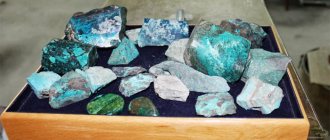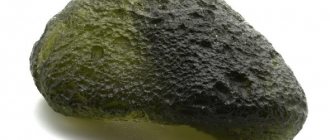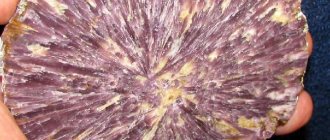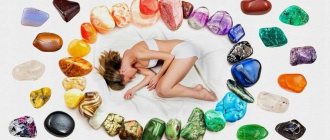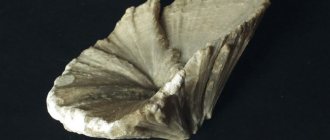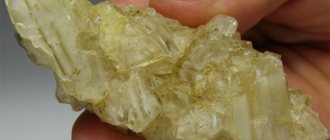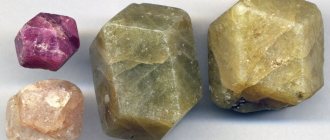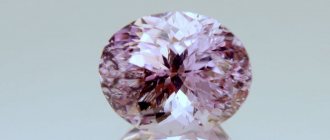Story
Paraiba is one of the few gemstones whose time, place of birth and “parent” are known with certainty.
His story begins in 1987. In the summer, the world jewelry market was rocked by a sensation. The Brazilian state of Paraiba, which delights the world with multi-colored tourmalines, has presented a new variety of stone.
It was discovered by a prospector with many years of experience, Heitor Barbosa. He believed in the potential of the State of Paraiba and deliberately dug it up with his team.
At this point, exact information gives way to versions:
- According to the first, the find turned out to be insidious. Out of joy, the elderly man’s health deteriorated and he was out of action for a long time. And when he returned, the deposit was exhausted.
- The second claims that Barbosa offered the Paraiba to a reseller. The successful merchant did not show that the stone was unique. I tried to buy it for next to nothing, but it was impossible to deceive Barbosa. We agreed on a price that we were both happy with. They say that Paraibas have been seen for several years.
Its presentation at an exhibition in Arizona in 1990 was the beginning of a worldwide triumph. They fought hard for the stone, the price per carat soared from a couple of hundred to $2000.
Today, high-quality Brazilian tourmaline costs five times more per carat.
Where is the gem born and mined?
A few years after the discovery of the crystal, the same stones were found in Mozambique and Madagascar. The first deposit was quickly developed, but then a new one was found in Brazil - in a state called Rio Grande do Norte.
Not long ago, neon crystals were discovered in Nigeria. Scientists explain this by the movement of geological plates. All stones were “born” under the same conditions on the continent of Pangea. After the separation of the continents, the mineral deposits also separated.
Today, large jewelry companies only recognize Brazilian Paraiba stone. It is considered “true” and of the highest quality. Other crystals are considered indigolites and are called type paraiba - stones of the Paraiba type.
Natural neon crystals in stores are a huge rarity; they are not available to ordinary customers, so Paraiba in jewelry stores is usually an imitation.
What is Paraiba
A turquoise Paraiba crystal completes the iridescent tourmaline palette.
It is transparent and shines like glass. Connoisseurs compare the color to the surface of the sea and the sky.
The stone is characterized by a charming play of light on its edges in daylight or artificial light.
The main feature is the glow. At dusk, the stone emits light without creating shadows. This property allows Paraiba to be distinguished from other tourmalines.
Fans call it neon or electric.
Physico-chemical characteristics
Paraiba is a tourmaline.
Its chemical composition includes ions of sodium, calcium, lithium, iron, magnesium, manganese, aluminum, gallium and vanadium. Paraiba crystals are anisotropic, have a trigonal system, glassy luster, and have no cleavage. Paraiba is painted in shades of blue, blue, violet and green in their combination.
Hardness on the Mohs scale is 7-7.5. Specific gravity 3.06 g/cm3. Refractive index 1.624-1.644. Birefringence: 0.018-0.040. Variance: 0.017
Paraiba tourmaline
The exorbitant cost of the mineral Paraiba tourmaline has given rise to a wave of experiments. They were taken up by both scientists and amateur “alchemists”.
Traditional manufacturing methods
The most common methods:
- Heat green tourmaline to 600°C. The stone turns blue, but the neon effect disappears.
- Use copper electrophoresis. Copper penetrates shallowly into the green stone; any scratch reveals the imitation.
- Heat purple tourmaline for a long time in an acidic environment. The stone will become discolored, but the green reflection turns out to be “brutal” and is visible only on the upper layers. This is detected under a microscope.
- Heat the same violet sample, then irradiate it. The effect is achieved quickly; only special equipment can detect a fake.
Only a nuclear accelerator can be guaranteed to “impregnate” an entire stone with copper. However, the procedure is not cost-effective.
Nanotechnology
A more modern, cheaper method is the use of nanotechnology. China is the first on the market for this position.
Companies in the country offer products for less than $10 per jewelry insert. The origin is disclosed in the product description, indicating the material as “Nano gemstones, created in a laboratory.” Dimensions are metric (eg 10mm diameter) and not carat.
The nano sample looks like natural Paraiba in good condition.
Decorations
Every piece of jewelry with Paraiba tourmaline is doomed to success. World-famous jewelry houses such as Dior, Tiffany, Spark Creations, etc. know this and actively use it. Jewelry with a famous gem looks great framed in yellow or white gold and in combination with diamonds, as well as colorful precious stones, such as sapphires or emeralds.
Tiffany
Tiffany & Co has exclusive purchasing authority for all neon gems over 3 carats. She bought more than 70% of Paraiba tourmalines, and then organized a project to promote her jewelry with this stone and in 5 years had already earned more than 100 million US dollars.
The natural gemstone Paraiba tourmaline is used only in luxury jewelry, often created in a single copy to order, and is sold at exorbitant prices. But it is worth it, which becomes obvious at one glance at its magical hypnotic glow and unique heavenly purity.
Review of Paraiba tourmaline at the exhibition:
Place of Birth
In addition to Brazil, Paraiba tourmaline stone is mined in West Africa. Scientists suggested this place:
- When the supercontinent Gondwana existed on Earth, these regions were “neighbors.”
- Millions of years ago, Gondwana split into modern continents.
- Half a billion years earlier, pegmatite deposits formed on the land that became Africa and South America. This type of granite is the source of many gems, including tourmalines.
It was only at the beginning of the new millennium, when Brazilian sources dried up, that they thought of looking for paraiba on the African coast of the Atlantic Ocean.
Nigeria (Eduku mine) and Mozambique (Muyane deposit) were pleased. The stones differ from the Brazilian “original”: Nigerian ones are paler, Mozambican Paraibas have a lower percentage of copper and more impurities. But both types of stone are valued.
Where is it used?
The value of the stone determined the areas of application:
- Investment object. The cost of Paraiba grows every year. The less raw materials remain in the deposits, the faster the price rise process (+20-30% annually). Even stones from Africa are suitable, not to mention real Brazilian ones.
- Jewelry. Blue or turquoise stone goes well with gold and platinum.
Ring with Paraiba tourmaline
Earrings, a pendant, a ring, a ring with Paraiba tourmaline will immediately indicate the status of the owner.
- Collecting. Raw samples from various mines on the planet are a worthy goal for a collector. And also a reliable investment.
In all cases, you need to carefully study the accompanying documents for the stone so as not to buy a fake.
How to wear and care
Having got a Paraiba, you need to care for it like a titled “special one”:
- Select a separate box.
- Protect products from falls, impacts, hot sun, and water.
- Leave the cleaning to a professional. If not possible, use warm water and a mild detergent. Do not delay the water procedure.
Strict adherence to the rules applies to natural stone. With nanoproducts the regime can be weakened. For example, wear jewelry to the pool, to the beach, or for a walk on a sunny afternoon. Strength testing is not recommended.
Who is it suitable for?
Of all the signs of the Zodiac, the stone finds harmony most with Pisces, Cancer and Scorpio. It will be a powerful amulet for Libra and Aquarius. But Virgos and Capricorns are not recommended to wear the gem due to different energy levels. For other signs, the mineral will become neutral - it will bring neither benefit nor harm.
In any case, when buying a Paraiba, follow your gut feelings. If you feel positive energy from it, then you can safely purchase it.
Magic properties
Esotericists have studied the gem little due to its rarity and high cost. It is only clear that the magical properties of Paraiba tourmaline have the same effect as indigolites (blue tourmalines):
- This is a talisman for creative people, giving inspiration, creative thinking, and flights of imagination.
- Gives others physical strength. Helps you appreciate familiar surroundings and familiar people in a new way.
- Saturated specimens are a strong sexual stimulant. The magic of Paraiba will make men more brutal, more attractive in the eyes of their beloved person. A lady can become uncontrollable with him, so you need to think carefully when planning to give such a gift.
It is safer to choose a copy of calm shades.
Jewelry with Paraiba tourmaline
Use of natural paraiba and its price
Paraiba tourmaline is rare and is used only in jewelry. This stone can cost over 20 thousand dollars per carat. For comparison: regular tourmaline costs $200-500 per carat. Usually the size of Paraiba does not exceed 8 carats.
Jewelry with natural crystal is considered elite and is the crowning achievement of the collections of large jewelry houses. The main products used are yellow and white gold, platinum, and the companions of the turquoise stone are diamonds. One of the best is considered to be the jewelry of Lydia Courtel, an artist from France. They shine at fashion designer Karl Lagerfeld's shows. Her collection of paraiba pieces with a nautical theme is especially popular.
The stone is used for any jewelry, but it is believed that its optical properties are best revealed when inserted into a ring. It is customary to wear Paraiba products in the evening. There are no restrictions on gender or age.
To make your jewelry last longer, it should be stored away from sunlight. You cannot clean the stone with chemicals. For cleaning, use only running water.
Therapeutic effect
Lithotherapists have confirmed the importance of Paraiba tourmaline in solving mental problems:
- Stress, depression, intense, conflict-prone work.
- Anxious, short-term sleep.
- Internal dissatisfaction, low self-esteem.
In addition to the emotional, the stone is used on the physical plane. Supports the functioning of the thyroid gland, endocrine, genitourinary, cardiovascular, and circulatory systems.
Contemplating the crystal in the light relieves eye fatigue, dryness, and redness. This is especially valuable for those who love or are forced to sit in front of the monitor for hours.
They say the stone can inhibit cancer.
It is prescribed to increase potency.
If everything is in order with your health, the crystal is suitable for strengthening the immune system.
A little about the properties of Paraiba tourmaline
Thanks to its truly unearthly beauty, it is not for nothing that many people claim that it is the most beautiful stone on the entire globe. It is compared either to a clear sky or to clear bluish water sparkling in the rays of the summer sun. The light of this miracle of nature is diffused within it in a special way, without weakening its intensity, which makes it especially bright.
If you cut Paraiba tourmaline and place it in the sun, you will see that it does not cast a shadow. This phenomenon is clearly visible in many photographs of tourmaline. It's like a colored light bulb, the only difference is that it doesn't need electrical power!
Paraiba tourmaline is also famous for other, no less interesting phenomena that may be of interest to any specialist in the field of optics.
In the heart of the stone, a greenish color is clearly visible, which is an intricately shaped spot - it simply looks magical against the overall bluish background. This effect is called neon glow, despite the fact that experts criticize it and believe that tourmalines do not have luminescent properties.


